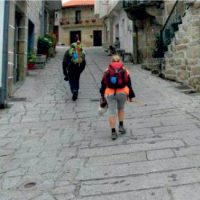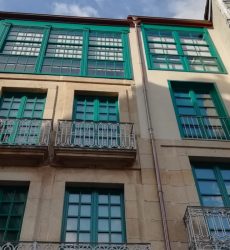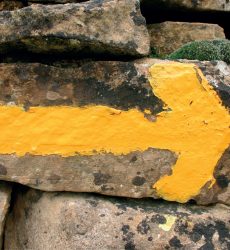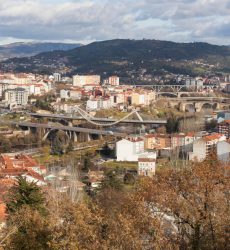
The Way to Santiago
The presence of thermal waters, great relief for the walker's feet, together with its strategic situation, have made Ourense a landmark in the Way to Santiago since its inception. Today it is still a must stop on the Mozarabic Way, which is followed by the walkers from southern Spain.
The Mozarabic Way – Vía de la Plata
The Vía de la Plata or Mozarabic Way connects Santiago de Compostela with the south of the Iberian Peninsula, traditionally starting in Seville. It is the longest pilgrim itinerary in Galicia (about 200 km long) and brings together a wide variety of landscapes and historical heritage that endow it with exceptional beauty.
Its origin dates back to an old Roman road that linked Merida with Astorga. This route was kept alive during the Middle Ages, first with the Visigoths and then under Islamic rule (in fact, the name “Vía de la Plata” comes from the Arabic “bal’latta”). Later the Mozarabic Christians would use it to make a pilgrimage to Santiago from Andalusia and Extremadura.
From La Granja de la Moreruela (Zamora) this path enters Galicia through A Gudiña. Here you can choose between two routes, one through Laza and the other through Verín, which later join in Ourense, the first and only Galician city before Santiago.
From here there are 100 kilometres to Santiago, the minimum to get the Compostela certificate. Why not to choose Ourense as the trailhead for the Jubilee?
Pilgrim’s Credentials
Pilgrim’s Credentials is the passport in which the various seals of the Way to Santiago are stamped. You need it in order to sleep in official hostels and to obtain the Compostela, the council document certifying the completion of the pilgrimage for religious or spiritual reasons. To get this certificate, you must prove at least 100 kilometres on foot or horseback or 200 by bicycle.
You can buy the passport both at the Ourense Cathedral (+34 988 22 09 92) and the Association of Friends of the Way (+34 988 39 11 10). Please check opening hours.
· On the occasion of the Xacobeo Jubilee Year 2021-2022, the National Police also stamps and issues free Credentials (24h hours).
Signaling
 The yellow arrow is the most common sign that you will find on the Camino de Santiago; it always indicates the direction to follow. Another common symbol is the scallop shell, St. James’ other emblem. Symbol of life evoking water, the shell represents the convergence of the multiple Paths of Europe in Santiago. It only identifies the route of the Camino, not the direction.
The yellow arrow is the most common sign that you will find on the Camino de Santiago; it always indicates the direction to follow. Another common symbol is the scallop shell, St. James’ other emblem. Symbol of life evoking water, the shell represents the convergence of the multiple Paths of Europe in Santiago. It only identifies the route of the Camino, not the direction.
In the province of Ourense you will also find many stones made by sculptor Carballo to guide yourself. Each one is different. Discover them!
The Way in Ourense
Ourense receives the pilgrims in the rural village of Seixalbo, a set of ethnographic value still retaining its medieval trace. From there, the Way enters the city from the south, going through Zamora Avenue and Progreso Street to As Burgas, the hot springs which every pilgrim must visit since the Middle Ages.
A gentle climb leads to the new pilgrim hostel, just a few metres away from the Main Square, from where you can see St. Martin’s Cathedral, a transitional Romanesque temple in which you should visit the Chapel of the Holy Christ and the polychrome Gate of Paradise. In the nearby streets, the Os Viños winery area is ideal for discovering the best of the local cuisine in the form of tapas and snacks.
The Way continues to the Roman Bridge, the oldest bridge of the city. After crossing it, there are several alternatives.
- The Eastern detour leads us from Santiago Avenue to the ancient Royal Way, where you will find the village of Cudeiro.
- The Western detour follows instead the N-120 road to the hill of Canedo.
- It is also possible, once you have crossed the Roman Bridge, to take River Minho’s thermal route and enjoy a comforting bath. This route connects in Quintela with the Western detour.
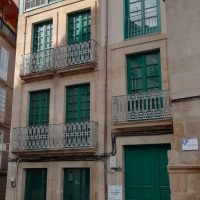
Where to Sleep
In 2018, Xacobeo’s new official pilgrim hostel opened on Barreira Street, next to As Burgas hot springs: the thermal sources whose waters have been a gift for pilgrims and travellers for centuries.
Ourense is the first big city after many kilometres of Camino, so pilgrims have the possibility to choose an alternative accommodation: hotels and hostels in which to rest, but also to enjoy the lively urban environment and the peace of the hot springs.
More Information
Addresses and Telephone Numbers
Ourense CATHEDRAL
Purchase and sealing of the pilgrim’s credential. + info
ASSOCIATION OF FRIENDS Via da Prata – Camiño Mozárabe
- Attention and information for pilgrims. Purchase and sealing of the pilgrim’s credential.
Praza das Damas S/N (CEO) See on Map +34 988 391 110
service map
Map with geolocated services of interest to pilgrims as they pass through Ourense.
See map online
Download KLM
Official hostel for the Way to Santiago, located next to the hot springs of As Burgas.

